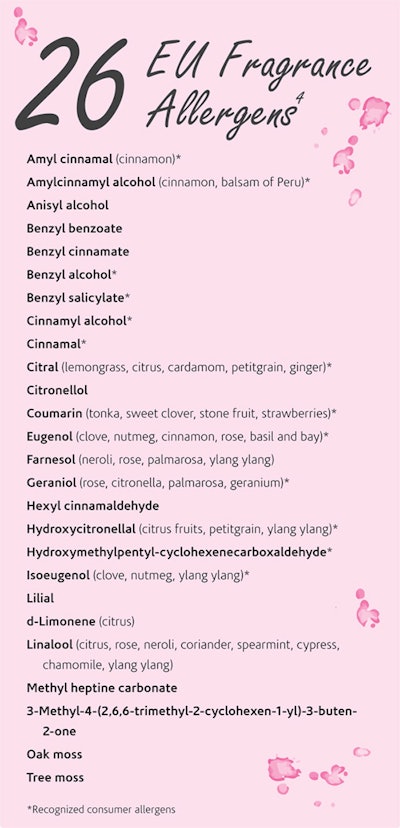
As one of our main senses, smell is a key part of how we react to situations and others in our everyday life. We look to re-create a happy memory or positive feeling with a certain fragrance. Fragrance is in laundry, cleaning products and personal care products as well as being pumped through vents at our favorite stores. Considering that 2-11% of the population is affected by fragrance allergy, the professional skin care industry needs to know more about fragrance allergens.1 The International Academy of Dermatology has listed fragrance at number four in its Top 10 Allergens. Understanding fragrance labeling, common fragrance allergens, signs of fragrance allergy and the interaction between sensitive skin conditions and fragrance will help skin care professionals recommend the right products for sensitive clients.
Fragrance on a Label
Fragrance ingredients in cosmetics are the most common cause of contact dermatitis; they represent 30-45% of allergic reactions. The International Nomenclature of Cosmetic Ingredients (INCI) name for a fragrance in a product is Fragrance (parfum). A fragrance may contain anywhere from one to more than 400 individual components that are specific chemical entities.2 When you see Fragrance (parfum) on an ingredient label, it could be either a completely natural fragrance or synthetic fragrance. Some U.S. manufacturers list the fragrance in their products, while others do not. Detailing fragrance components is not required by U.S. product manufacturers at this time, but it is required by manufacturers in the European Union (EU).
Using products that list the fragrance is helpful when dealing with sensitive or health-challenged skin, as skin care professionals wish to “do no harm.” There is no legal definition to “fragrance-free” or “unscented.”3 These claims often mean there is no apparent scent, but fragrance allergens can still be present. For example, many manufacturers use essential oils as masking agents to cover up an unpleasant natural scent.
Asking questions of the product manufacturer is always suggested. While some ingredients may sound like they are there for a fragrance purpose, others may provide scent but serve another purpose in the formula. For example, Lonicera japonica (honeysuckle) flower extract is currently used in many skin care products as part of the preservative.
Another term of concern that has popped up in the industry is phthalates. These are added to synthetic fragrances to extend a scent’s lifespan, but research has suggested that they accumulate in the body and affect hormone production. Many companies have reformulated their products without phthalates and are labeling them as such.
Fragrance Allergens
One must realize that both synthetic and natural fragrances may contain known allergens. Allergens also can be present in essential oils commonly used in skin care products. As stated, skin care brands sold in the EU are required to list possible allergens on their labels (see 26 EU Fragrance Allergens);4 and of the 26 fragrance allergens identified, many of the first 12 are found in plants.

Eight essential oils in particular are found to be extremely reactive in skin care, including: Cadanga odorata (ylang ylang), Eugenia caryophyllus (clove leaf/flower), Evernia furfuracea extract (treemoss), Evernia prunastri extract (oakmoss), Jasminum grandiflorum/officinale (jasmine), Myroxylon pereirae (balsam of Peru), Santalum album (Indian sandalwood) and turpentine oil (pine tree).
Recognizing an Allergy
Allergic reactions in general can present in a variety of ways, from a rash to sneezing and migraines, and different types of reactions to fragrances may also occur. Skin irritation is the first response, which can happen right away. Other fragrance reactions can include one or more of the following: blisters, red bumps, itching or blotchiness. If the irritating ingredient is removed immediately, the irritation may resolve itself and not happen again if avoided. If an irritating ingredient is repeatedly used on the skin, sensitization may result. The client may end up with a full allergic response, which may become permanent. Repeated exposure to a fragrance allergen can also lead to contact dermatitis or eczema. Photosensitization can also occur, making the client’s skin sensitive to light exposure.
When dealing with suspected contact dermatitis or eczema due to fragrance, it is best to refer the client to a dermatologist, who will perform some definitive patch testing to determine the specific fragrance ingredients causing the reaction. After an allergic reaction to fragrances, a dermatologist may prescribe antihistamine pills or injection, a corticosteroid and a simple skin care routine, depending on whether the reaction was mild or severe.6
Estheticians should allow their client’s skin to calm after any reaction, as some medications prescribed by the physician may also have contraindications. Performing a service on the client at such a time will be counterproductive due to the ultra-sensitivity of the client’s skin.
Spa Precautions
When designing treatments and recommending products for individuals with skin sensitivity, skin care professionals must take special care. Offering products that include hydrating, calming, antibacterial and antimicrobial ingredients will be beneficial. Having microfiber towels on hand, using nitrile gloves and avoiding the use of steam or hot towels will also help keep the skin from becoming more irritated and red.
Beyond spas, businesses also are taking note of sensitivities to fragrances. Halifax, Canada, for example, is one of the most scent-aware locations in North America. Businesses, educational institutions, hospitals and government locations all follow scent-awareness policies. While not enforceable, they are a code of conduct. Hospitals, especially those dealing with terminally ill or oncology patients, request that employees not wear fragrance, as patients dealing with health challenges are much more easily irritated by fragrance.
Skin care professionals should be aware of a client’s fragrance allergies or preference for fragrance avoidance. This could be determined by questions on the intake form, or even asked at the time of booking a service. It would be advisable to design fragrance-free facials for anyone who shows any type of contraindication on their intak form.
Also, some clients do not like the smell of a certain fragrance, and while their skin may look incredible after a service, the relaxation aspect may be interrupted by it. If working with fragrant product lines, scheduling that client early in the day when the scent has not permeated the room could help them enjoy that service more. Having an alternative product line with no fragrance may also help.
Spa owners should consider the fragrance in the entire spa setting as well. Many spas use fragranced candles or diffusers to set a relaxing environment and frame the spa experience. Fragrance is also used in bathrooms and changing rooms, as fragrances in cleaning chemicals can also have an effect on some clients. Try switching to fragrance-free detergents for linens and cleaners. Employees’ own fragrances and personal care products can even have an effect on particular clients, especially those going through hormonal changes or medical treatments. How fragrance is being incorporated into a spa setting should be reviewed and altered if necessary.
Consider Fragrance
There are more than 2,500 known fragrances used in perfumed consumer goods, such as cosmetics, skin care and household cleaning products.7 Skin professionals need to consider how these fragrances are interacting with their clients and learn about fragrance allergens. Taking time during the initial visit to ask questions about their lifestyle, work environment, home care products (including cleaning products), etc., will help to determine the potential for possible sensitivity issues due to fragrance allergy.
The number of people claiming to have sensitive skin is growing, making it time to think about fragrance to accommodate this growing clientele.
References
- www.womensvoices.org/wp-content/uploads/2013/02/Secret-Scents-report.pdf
- L Walker, The Skin Care Ingredient Handbook, second edition, Allured Publishing: Carol Stream, IL (Nov 15, 2014)
- www.cosmeticsdesign.com/Regulation-Safety/Report-claims-fragrance-allergies-as-common-culprit-in-skin-conditions
- http://ec.europa.eu/health/scientific_committees/opinions_layman/perfume-allergies/en/l-3/1-introduction.htm
- http://ec.europa.eu/health/scientific_committees/consumer_safety/docs/sccs_o_102.pdf
- www.aad.org/public/diseases/eczema/contact-dermatitis
- http://ec.europa.eu/health/scientific_committees/opinions_layman/perfume-allergies/en/index. htm#il1











